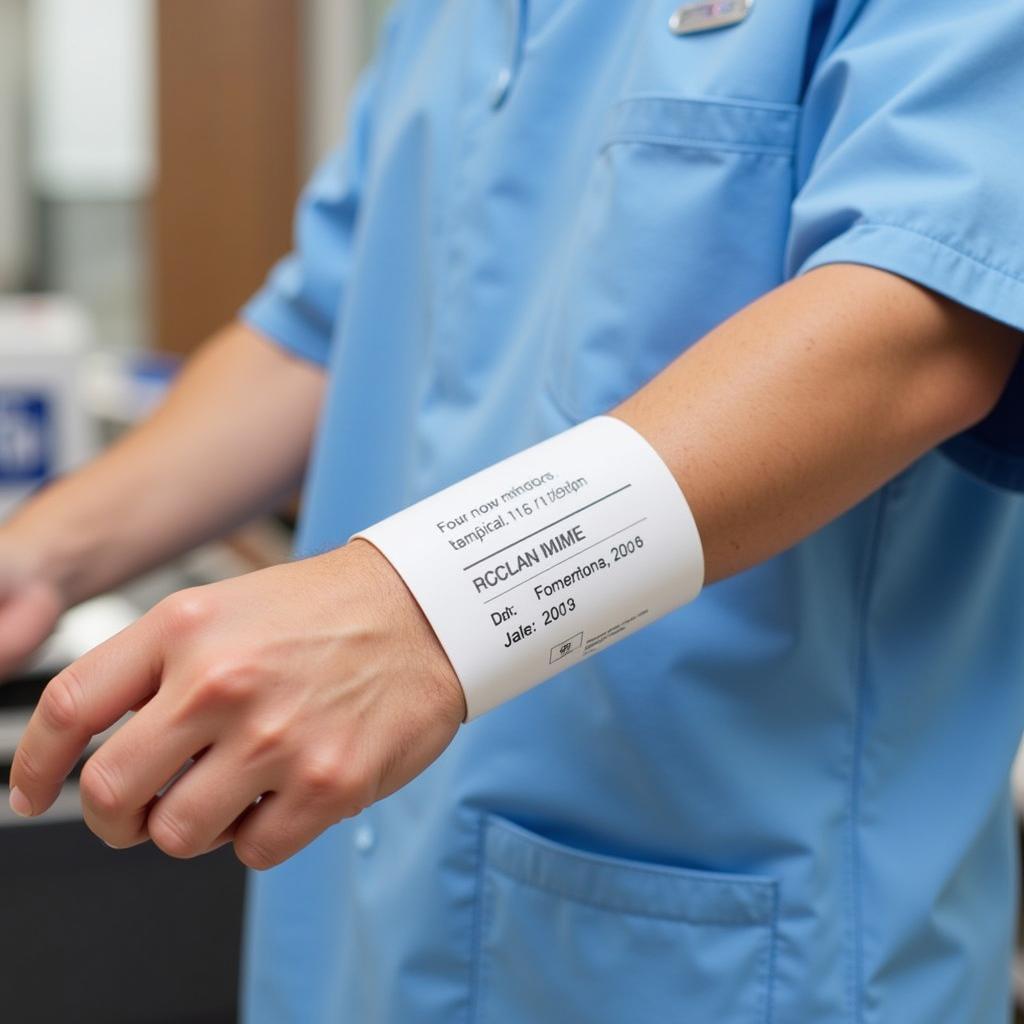Hospital Armbands are a critical component of patient safety and identification in any healthcare setting. Within the first moments of a patient’s arrival, these seemingly simple bands play a vital role in ensuring accurate identification, streamlining care, and minimizing potential errors. They are essential tools that contribute to a safer and more efficient healthcare experience for everyone involved, from patients and their families to medical professionals.
Understanding the Importance of Hospital Armbands
Hospital armbands are far more than just identification bracelets. They serve as a crucial link between the patient and their medical information, medications, allergies, and specific care needs. This information is readily accessible to healthcare providers, enabling them to make informed decisions quickly and accurately.
Why are Hospital Armbands Essential for Patient Safety?
Hospital armbands are the first line of defense against medical errors, particularly those related to patient misidentification. These errors can have severe consequences, ranging from administering the wrong medication to performing a procedure on the wrong patient. The armband provides a constant, visible, and readily accessible source of patient identification, minimizing the risk of such errors. This simple band can significantly improve patient safety and contribute to a more secure healthcare environment.
 Hospital Armband on Patient's Wrist for Identification
Hospital Armband on Patient's Wrist for Identification
Different Types of Hospital Armbands
There are various types of hospital armbands available, each designed for specific purposes and patient demographics. Common types include:
- Standard armbands: These are the most common type, featuring basic patient information such as name, date of birth, and medical record number.
- Pediatric armbands: Designed for infants and children, these armbands are smaller and often feature brighter colors or fun designs to make them less intimidating.
- Allergy armbands: These brightly colored bands prominently display the patient’s allergies, alerting healthcare providers to potential sensitivities.
- Fall risk armbands: These bands, typically red or yellow, quickly identify patients at risk of falling, allowing staff to take appropriate precautions.
The Role of Technology in Hospital Armbands
Technological advancements have revolutionized hospital armbands, enhancing their functionality and improving patient safety. Barcodes and RFID tags embedded within the armbands allow for quick and accurate electronic identification, reducing the risk of human error. This technology also enables real-time tracking of patients, streamlining workflows and improving efficiency.
How do Barcodes and RFID Enhance Patient Safety?
Barcodes and RFID technology on hospital armbands allow healthcare professionals to quickly and accurately access a patient’s medical records. This eliminates the need for manual data entry, which can be time-consuming and prone to errors. By simply scanning the armband, healthcare providers can instantly verify patient identity, access medical history, and administer medications safely.
What are the benefits of using RFID in hospital armbands?
RFID technology allows for real-time tracking of patients, which can be particularly beneficial in emergency situations or for patients with cognitive impairments. This tracking capability enhances patient safety by ensuring that patients are easily located when needed.
Hospital Armbands and Patient Experience
Beyond safety and efficiency, hospital armbands contribute to a positive patient experience. By providing accurate identification, these bands ensure that patients receive the correct treatment and medications, reducing anxiety and fostering trust in the healthcare system.
How do Hospital Armbands Improve Patient Satisfaction?
Hospital armbands streamline the patient identification process, minimizing delays and ensuring a smoother experience. This can be especially important for patients who are feeling unwell or anxious. By ensuring accurate identification, armbands contribute to a more efficient and less stressful healthcare experience.
Conclusion
Hospital armbands are an indispensable tool for patient safety and efficient healthcare delivery. From accurate identification and medication administration to real-time tracking and enhanced communication, these simple bands play a crucial role in improving patient outcomes and fostering a positive healthcare experience. Investing in high-quality hospital armbands is a vital step towards creating a safer and more efficient healthcare environment for everyone.
FAQ
- What information is typically included on a hospital armband?
- Are hospital armbands waterproof?
- How are hospital armbands disposed of?
- Can a patient refuse to wear a hospital armband?
- How long does a patient typically wear a hospital armband?
- What are the different types of armband closures available?
- What is the cost of hospital armbands?
Common Scenarios and Questions
-
Scenario: A patient is unconscious and unable to provide identification.
-
Question: How does the hospital armband ensure proper identification in this situation?
-
Scenario: A patient has a severe allergy to latex.
-
Question: What type of armband is used to alert medical staff about this allergy?
-
Scenario: A child is admitted to the hospital.
-
Question: Are there specific armbands designed for pediatric patients?
Further Reading
For more information on patient safety and healthcare best practices, please visit our website’s resources section. You can also find additional information about our hospital’s commitment to patient care and our advanced technologies.
When you need assistance, please contact Phone Number: 02437655121, Email: [email protected] or visit us at: 298 Cau Dien Street, Minh Khai, Bac Tu Liem, Hanoi, Vietnam. We have a 24/7 customer service team.